The untold good news story of America today
- Published
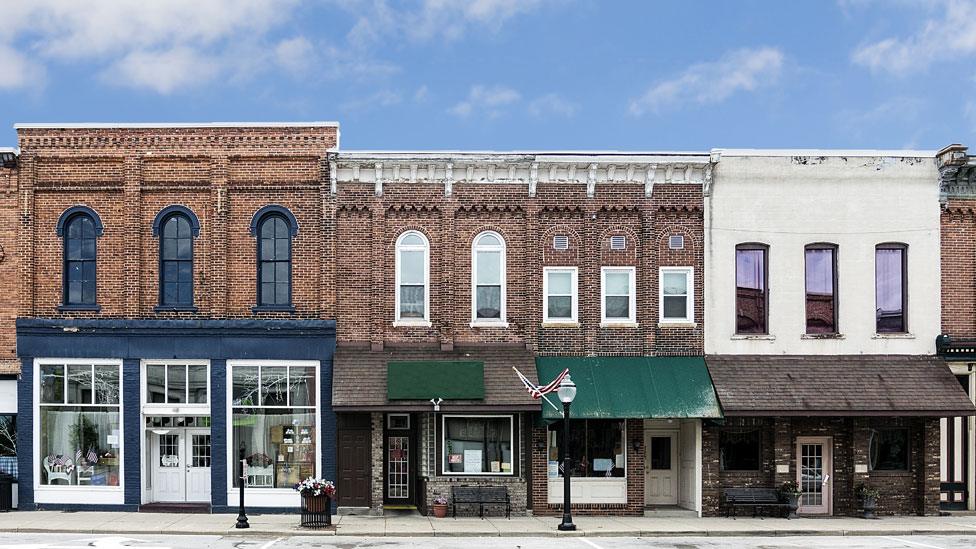
Political bickering has long been a roadblock to getting big things done in the US but a grassroots movement getting few headlines could yet herald a new American age of change.
A green giant in a loin cloth would seem an unlikely indicator for what some describe as a revolution under way in the heart of America.
But the Jolly Green Giant statue on Highway 169 in rural Minnesota wears a 48-inch (1.2m) smile for a reason.
Accompanied by the slogan Dream Big, he typifies a sense of hope and renewal in the nearby city of Blue Earth that is quietly being echoed across parts of the US.
As the country continues its long recovery from recession, there are signs that a much deeper shift is happening at a local level, the seeds of which were sown years ago.
Indicators far more subtle than job numbers suggest a flourishing of entrepreneurship, collaboration and problem-solving, away from the gaze of national media.
After five years spent visiting dozens of towns, The Atlantic writer James Fallows and his wife Deborah have written a book Our Towns which paints a portrait of renewal, a story at odds with the well-documented gridlock of higher levels of government.
Fallows says that in several areas - civic engagement, returning talent, growth of tech start-ups, downtown revitalisation, an openness to immigrants and thriving libraries - local America seems to be flourishing.
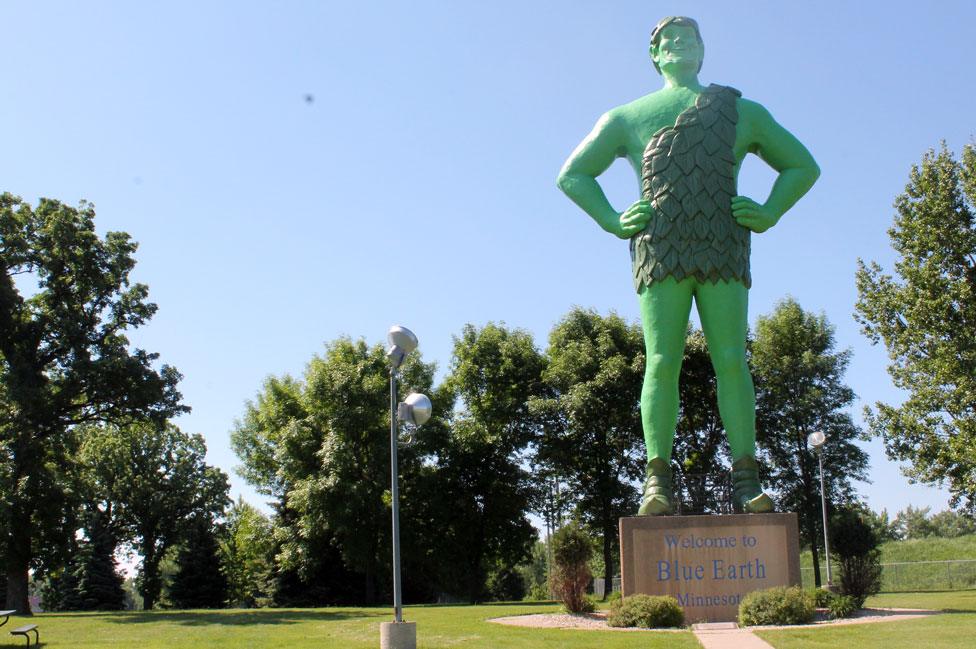
He's not alone. Another book called The New Localism says a growing number of US cities are addressing the problems of post-industrial America in increasingly imaginative and flexible ways - succeeding where bigger government fails.
There is also optimism from the world of tech. After visiting communities in the heart of the country, in a huge drive to help entrepreneurs, internet pioneer Steve Case, co-founder of AOL, says the future looks bright.
"I believe that we are entering the Third Wave of the internet, a period in which entrepreneurs will leverage technology to revolutionise major sectors of the economy - healthcare, financial services, agriculture and others," he says.
These deep, structural changes and bursts of creativity appear to be especially evident in cities and towns in the Midwest, long derided as "flyover country".
Now it's more like "flying back home country" as thousands of people return to their hometowns from bigger coastal cities, bringing with them new ideas and a drive to succeed.
Let's take a closer look.

Bouncing back
While the prairies that surround it are characteristically flat, Blue Earth - population 3,300 - has experienced more than a few bumps in the road.
The agricultural crisis of the 1980s caused by ballooning debt and falling incomes led to bankruptcies and an exodus from rural communities. This was especially felt in the Midwest and Blue Earth. Then out-of-town superstores and online shopping came along.
It was a succession of body blows for Blue Earth, which is named after the traces of blue residue found in the banks of its river. The town lost a fifth of its population.
But the feeling now on Main Street, where boarded up premises are slowly being replaced by new businesses, is that it is bouncing back.
College graduates are coming home again in their 20s and 30s, rather than heading to the big cities, reversing the years-long talent exodus. And some are returning with new business ideas and a determination to revive the fortunes of the town.

What's happening where you live?
This story came about because of reader response to our Ask America newsletter, external - where BBC readers are sharing stories and asking questions about America. Interested in receiving the newsletter? Send us an email at AskAmerica@bbc.co.uk, external

Tell us how your community is changing
Is there a local character who is the key to making things happen?
If you live outside the US, do you have any questions for Americans?
Email us at AskAmerica@bbc.co.uk

One resident who never went away is Blue Earth's green and famous 60ft (18m) landmark. The town has long had a Green Giant canning factory producing the famous tins of peas and corn, and the giant was erected in the 1970s to entice drivers into the town from the interstate highway.
It worked - the visitors' book near the statue suggests people from all over the world have dropped by for a photo.
But very few drove a further five minutes into the city centre.
So the change about to be wrought at the giant's feet could be a portent for the exciting future of the town itself.
A few yards from the giant's size 78 shoes is a construction site where a welcome centre is being built to showcase the town. The hope is that in future people will do more than stop for a selfie.

The giant keeps a watchful eye on the changes afoot
And like a trail of breadcrumbs in a Brothers Grimm fairytale, 16 smaller statues of the giant's younger sidekick Little Green Sprout are being designed and made by local artists, and placed around town.
Main Street is fresh from a facelift - the council reconfigured the street and offered grants to businesses to improve their shopfronts.
There is a new police station, a new water tower and swimming pool. In the works is a housing development targeting young families and a new sewage plant.
The new "British" roundabouts on the highway right under the giant's nose are another sign of investment, this time by the state of Minnesota.
But they stoked such confusion at first that "there wasn't three days when there wasn't a truck stuck on the top of it", according to one local.

One woman's vision
No such disorientation about the most ambitious plan to invigorate Main Street.
If one woman's vision comes to fruition, three abandoned buildings known as The Three Sisters will be converted into a space for artists, tech entrepreneurs, a coffee shop, wine bar, Italian restaurant and bakery.
Janie Hanson, 36, grew up on a nearby farm, and her family instilled in her the benefit of hard work and philanthropy.
She left the area to pursue three degrees, including an Ivy League university education in New York. But she has returned to Minnesota and wants to help transform her hometown, using her non-profit organisation Connect The Grey.
"I hope this project will be a catalyst to invigorate the community," she says. "I want to provide the platform for people with undiscovered talent the opportunity to pursue it."
The council agreed on Monday to give Hanson's $2.5m (£1.9m) plan the go-ahead, and to sell the site to her for $1.
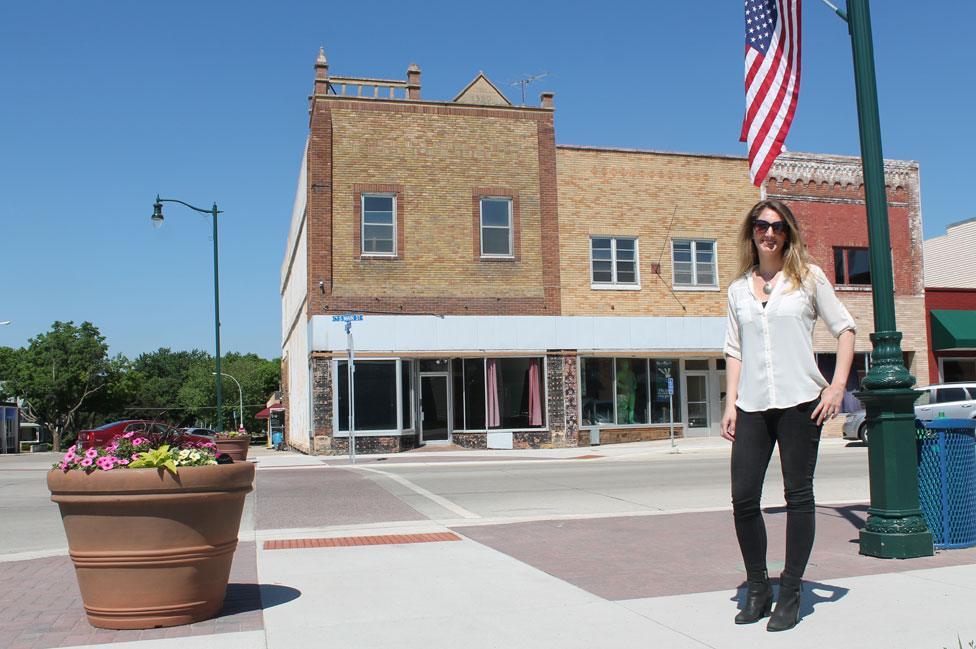
Hanson wants to transform the buildings behind her into something special
There are many others brimming with ideas in Blue Earth, many of whom came back from elsewhere with a determination to reinvent and survive.
There's John, a construction manager who bought a derelict building on Main Street and made it into a Norwegian brewery, after teaching himself how to do it.
Graphic designer Becki opened a new studio and art gallery that also sells high-end wool yarn and she holds weekly "stitch and bitch" nights for women.
Food blogger Stacie left Blue Earth to study nutrition and returned to live two blocks from Main Street, but now wants to start healthy living classes for local people.
Dietician Brooke married a professional ice hockey player and lived in Czech Republic, Germany and France, but has moved back and set up her own business.
And Bruce has his furniture store at the northern end of Main Street, with a cafe adjoining. If you're wondering why his vast space has some strangely curved walls, it's because it used to be a skating rink and a bowling alley, another change borne of survival as the town's population shrank.

The can-do spirit
Their qualities could not be more at odds with the image conveyed by national politics.
Year after year, the US government fights over how to fix the immigration system or overhaul the ailing healthcare system. It is unable to repair the country's decrepit roads and bridges. And it has to shut down when it can't agree on a budget.
Surveys suggest Americans believe political gridlock in Washington has even hurt the US economy. And economists don't disagree.
But two books published in the last few weeks say American cities, big and small, are filling the gap, getting things done in a way the authors believe could spark a new economic resurgence.

You may also like:

Fallows is convinced the country at a local level is in a state of renewal that defies the predominant narrative of political dysfunction and inaction.
His book reveals a proliferation of experiments and adaptations in cities like Holland in Michigan and Sioux Falls in South Dakota that cause him to think America has become "more like itself again".
Serious though the country's problems are, he says, the future is brighter than you would ever guess from national news coverage which fixates on the "trench warfare" of politics.

Parts of the nation are flourishing, he says, as distinctly American qualities come to the fore.
"The fundamental American bargain, for better and worse, has been a belief in fluidity, mobility, departure from convention, a willingness to overturn tradition," he says.
"This bias in American history is why the American countryside and cityscape looks less elegant than the long-protected pastureland of England or the villages of France. It's also been a crucial part of the openness and opportunity of the society, in cultural ways as well as economic."
He recognises that his country has fallen short of - and even contradicted - these ideals at times in its history, and the country still has immense challenges to overcome.
But the vibrancy of local America is an untold story, says Fallows, partly because there is a natural scepticism in the media and an inclination when visiting towns to always ask people about the national political drama.
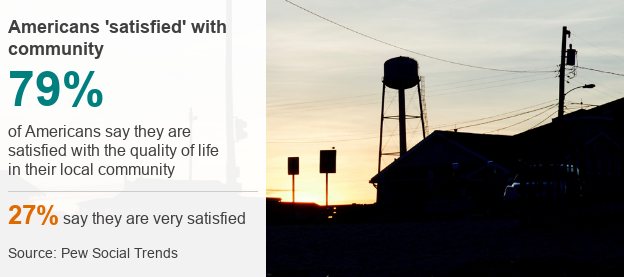
In Blue Earth, the city council members do not even govern as Democrats or Republicans.
And political parties were never mentioned in conversation.
People seemed to be universally happy about where the town is heading, while pointing out the things they think it desperately needs - healthy food options, more things to do at night, more "life" on Main Street.
"I really do feel that there's a resurgence right now," says Chuck Hunt, managing editor of the weekly newspaper, the Faribault County Register.
"I can't pinpoint one thing but the city council has helped, it's progressive and aggressive."

Waiting for cavalry
The renewal of town and city centres across the US is accelerating now, says Patrice Frey of Main Street America, a programme which helps to breathe life into commercial areas. It says it has generated $75bn in public and private investment since 1980.
How cities are rolling up their sleeves and getting things done is the subject of New Localism, a book co-authored by Bruce Katz of the Brookings Institution.
"For the past 40 years, we have seen an evolution of urban problem-solving that's becoming more sophisticated and more impactful with every passing year," he says.
This "localism" first emerged in the 1980s, he says, when cities began to realise that the "cavalry wasn't coming" from federal and state government, and they were going to have to tackle their problems on their own.
City leaders are discovering that problem-solving from the bottom up - in partnerships with others from the worlds of business, technology and education - is more democratic and effective, says Katz.
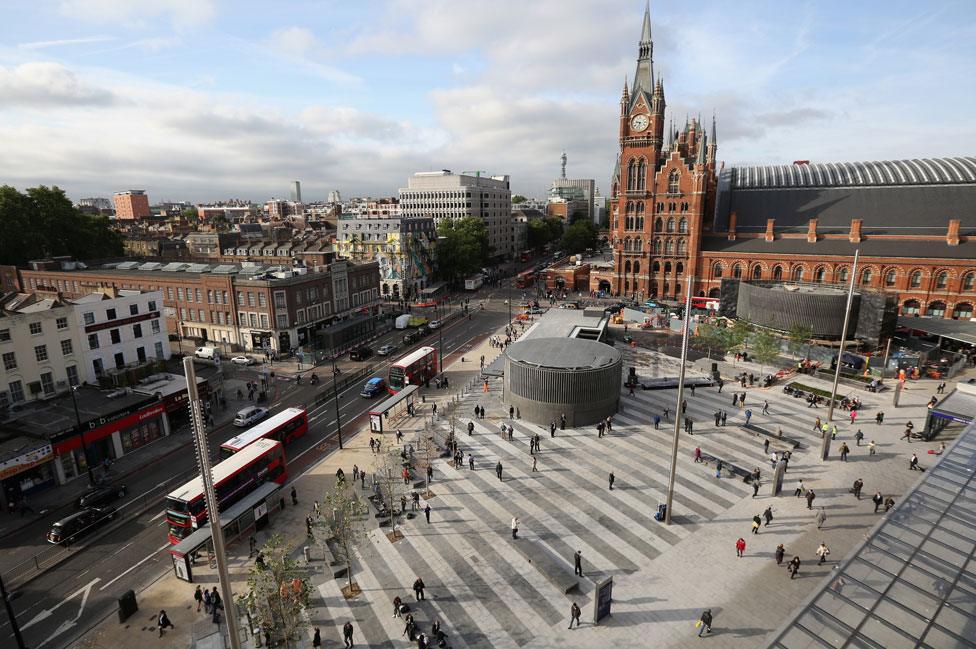
The regeneration of Kings Cross in London has been praised as a good example of this new kind of problem-solving
The 20th Century was very much about hierarchical systems that were segmented and bureaucratic, he says, while the 21st Century is going to be "networked, distributed and led by cities".
Instead of a decision made in Washington and delivered by a government department in the form of a one-size-fits-all policy, there might be a list of possible solutions from - for example - a collaboration between a mayor's office, a university and a local enterprise group.
This trend is accelerating and moving outside the US, says Katz. In his book, Copenhagen, Hamburg and Kings Cross in London are held up as good examples.
It comes at a time when a new generation of leaders - with the retirement of baby boomers - is coming to the fore, according to Pete Peterson of the school of public policy at Pepperdine University in California. These millennials are more collaborative, he says, and want to create a new narrative from what they see at the national level.

Kansas boom
Blue Earth does not have to look to Copenhagen for inspiration.
Kansas City, 380 miles (611km) south in Missouri, has seen a tech boom, a massive investment in the downtown and the installation of high-speed internet, courtesy of Google Fiber.
People in Kansas City discuss arrival of ultra-fast internet
The story of the city's reinvention began 20 years ago with a huge cash injection in the downtown, says Mike Mayer of Cushman & Wakefield, who has negotiated leases in the city worth nearly $2bn.
First Fridays began as a monthly attraction to showcase the city's growing arts scene, and that now brings 10,000 people to the city. The $100m KC Streetcar, a light rail system, opened in 2016 and that gave the city a sense of pride and helped to attract millennials.
A new $323m convention centre with 800 hotel rooms is due to open in 2020. Six years later, this sports-mad city could be hosting World Cup soccer matches. More and more outside money is pouring in, and the city's success is finally getting attention nationwide.
"There's still some pleasant surprise about the momentum here. It's a tad under the radar. They [investors] think it's a city of barbecues and jazz, and they come here and see it's got more legs," says Mayer.
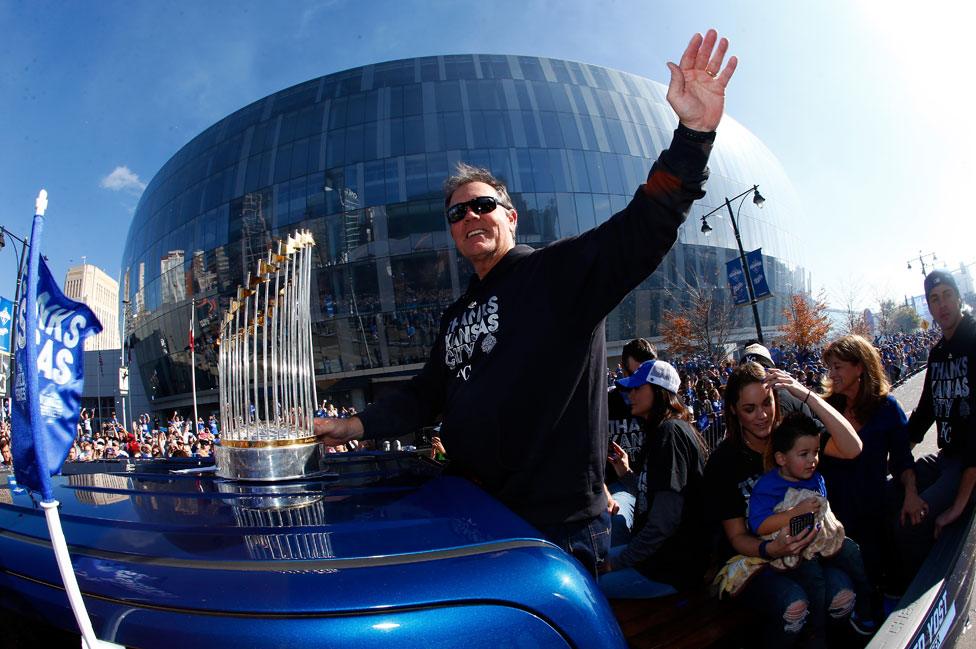
The Royals' baseball win in 2015 helped cement the Kansas City identity
One of the driving forces has been the Kauffman Foundation, which focuses on projects that encourage entrepreneurship and support education.
Matt Bramlette left a career in advertising to set up his own company three years ago - Mid Coast Modern sells handmade and home goods, with the support of local artists. The name is a pointed reference - typically, people get all their cool stuff from the east and west coasts, he says.
Having lived in Kansas City nearly all his life, Bramlette has seen it go from a "ghost-town" to one that's heading in the same direction as Portland, Oregon, or Austin, Texas.
He says the city has fostered an environment that is hugely supportive of local entrepreneurs, with lots of networking opportunities and a university six-week class for start-ups.
"Because there are so many entrepreneurs here, there is a sense of community that a bigger city may lack. We even support stores that are competitors and hope they do the same for us."
It helps that there is so much enthusiasm for locally made goods. "I'm not sure we could have survived without the local pride." Helped no end by the Royals winning baseball's World Series three years ago, he adds.

Exciting times ahead
There is no doubt there's a boom going on in small and midsized cities, especially away from the coasts, says leading investor and entrepreneur Steve Case.
He has visited 38 cities across the US with his company Revolution as it helps people with bright ideas to build their businesses, and he's seen "exciting progress" in each one.
The return of individuals from coastal cities to places where they grew up - the boomerang effect - is part of that, he says.
"Due to the renaissance occurring in rising cities, tech talent that previously saw Palo Alto or New York City as the only places where they could be successful are instead finding that they're able to launch and scale their companies with less overhead and a lower cost of living between the coasts."
How far can this go? A new book by photographer Niko Kallianiotis, external about communities in Pennsylvania provides a sharp reminder that the recovery is leaving many behind.

The challenges facing the US

But Bruce Katz sees an enormous opportunity in the growing strength of progressively minded cities to lower the achievement gap across racial, ethnic and class lines.
An "opportunity zone" tax incentive in the new tax law will entice investors and focus minds on upgrading the skills of young adults in deprived neighbourhoods, he says. The move enables states to designate low-income neighbourhoods and qualify them for favourable capital gains treatment.
"Mayors and their allies will leverage these private investments for dramatic effect, not just on economic growth but on economic growth that brings more and more lower-income residents into the labour force.
"So we are about to see a burst of institutional innovation and private investment in the US which will take New Localism to a whole other level."
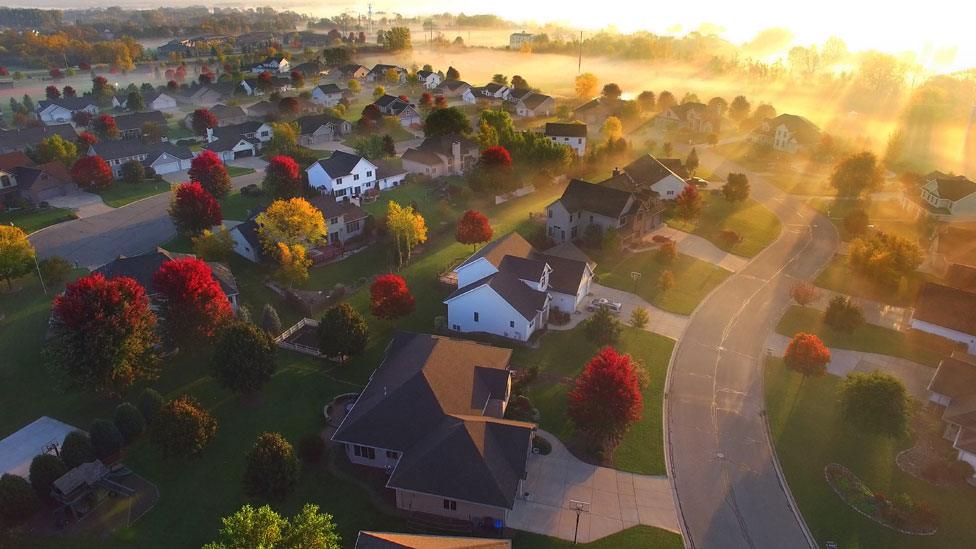
Exciting times.
There is very little trace of revolution on Main Street in Blue Earth, however, where the only movement one Thursday afternoon is the flutter of the American flags.
But the seeds of change are here, and in the town's cafe, Brooke Ziegler Hussey explains how.
"In small-town America you find the opposite of the problems of big government. They want to work together and help each other here. That's a huge difference."
Yes, Blue Earth has a long way to go on a path back to prosperity but like America, baby steps can lead to giant strides.